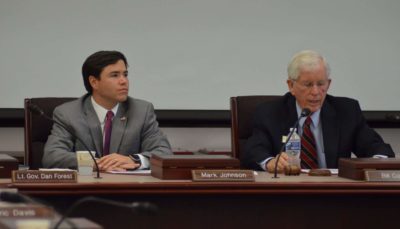Pamela Grundy’s Color & Character: West Charlotte High and the American Struggle over Educational Equality illustrates how complex national issues and deeply entrenched attitudes and beliefs about race and class have informed, and are informed by, the decisions of civic leaders in Charlotte, and the actions of Charlotte Mecklenburg Schools.
Grundy’s insightful book begins with the opening of West Charlotte High School in 1938 and then focuses on the years between 1970, when court-ordered busing helped establish the district as a national model for integration, and September 2016, when the police shooting of a black man, Keith Lamont Scott, ignited the pent-up anger of Charlotte’s African-American community whose students, today, attend highly segregated schools.
Both ethnographic and observational, Color & Character draws on hundreds of hours of interviews with teachers, graduates, administrators, and civic leaders as well as historical documents, news reports, and personal experience. With those Grundy tells a powerful story about the loss of community, the impact of corporate education reform, the unintended consequences of well-intentioned philanthropic interventions, and the persistence of race and class as determinants of educational performance and economic mobility.
Schools are systems, and like it or not, all systems are designed to get precisely the results that they get. Anyone working to help improve educational outcomes in Mecklenburg County – or who simply wants to understand why and how our current system of educating young people is defined by intractable and persistent attitudes, beliefs, and assumptions about race and class – would benefit from reading Color & Character: West Charlotte High and the American Struggle over Educational Equality.
Here is one example. In April 2017, the Charlotte Mecklenburg Board of Education voted to leapfrog down a list of prioritized capital projects to add an additional $127 million to an already large ($800 million) bond referendum package scheduled for a November 2017 vote. The decision appeared to represent the kind of backroom politics I was all too familiar with, having spent most of my professional life in New Jersey. Reading Grundy’s book helped me understand how decades of underinvestment in everything from gym lockers and athletic facilities, to curricular and extracurricular options at West Charlotte High legitimized and justified the inclusion of an additional $127 million for West Charlotte High School and Bruns Academy, a nearby elementary school.
In the fall of 1970, when the Charlotte Mecklenburg School District launched a dramatic and extensive desegregation effort, West Charlotte High School remained the only historically black high school in the district. In addition to the distribution of black students and teachers across predominantly white schools, white students – many from affluent communities and families who recognized the benefits of integrated schools – were transferred and/or bused to West Charlotte High. The impact was not an instant success. Obstacles, particularly those related to school culture and climate, required attention. Over time, teachers and administrators adjusted to a new and different reality; students began to understand and value each other; families talked through concerns around kitchen tables; and community issues were surfaced and addressed in barber shops and beauty salons on Saturday afternoons, and from pulpits on Sunday mornings. Change, with all of its consequences, challenge and historic significance, had arrived in West Charlotte.
By the mid-1970s West Charlotte High was hailed as a national exemplar for integration. Students and civic leaders from as far away as Boston visited to find out how a once-reluctant Southern city had made so much progress in a relatively short time. All the while, black students and their families, now attending predominately white schools, were becoming increasingly aware of the disparity of resources. The largely white schools seemed to have better everything – better band uniforms, athletic fields, coaches, science labs, books and teachers. Black parents and students began to demand equity across all schools in the district.
In the 40-plus years since West Charlotte became a national model for integration, Charlotte has re-segregated itself through a combination of accelerated white exodus to neighborhoods near the edge of the county as well as to other counties, and to private and charter schools; the absence of neighborhoods of mixed-income housing; a 1999 decision by U.S. District Judge Robert Potter ending court-ordered busing; and a 2002 district “Choice Plan” that included “Home Zone Schools.”
By 2002, West Charlotte High School was largely black and low-income, with less than two-thirds of the teaching staff fully certified. When, in 2006, a bonus of $10,000 was offered to high-performing CMS teachers willing to teach in a low-performing school, not one chose to work at West Charlotte High School. The once high-performing West Charlotte High gradually declined in performance until, by the end of the 2000s, it was consistently ranked among the lowest of the low-performing high schools in the state.
Grundy vividly illustrates how complex and deeply intractable the societal issues are that we continue to confront in Charlotte and across the country. The book helped me develop a more nuanced understanding of the historical context of the institutions and programs that I, through my work as the president of MeckEd, seek to improve, and the culture and history of the young people we serve.
Building a future where all children have access to opportunity, the resources they deserve, and the conditions necessary to thrive is my mission, MeckEd’s mission, and the driving force behind our programs and advocacy initiatives. While all young people have needs, many face obstacles that limit their access to a bright future. Generations of West Charlotte children and families have been at or near the bottom of too many lists, including, especially, education and economic mobility. They need and deserve more from us.
I remain optimistic that we are turning a generational corner and that our collective embrace of a more communitarian and sustainable set of values and moral principles is just on the horizon. That gives me hope. That and the fact that the full $922 million referendum passed in November by a whopping 3 to 1 margin, including the $127 million for West Charlotte.
I envision a day when young people are nurtured, supported and sustained in strong, thriving, healthy communities like those described by so many West Charlotte alumni in Grundy’s book.
It is up to us to ensure that the hopes and dreams of the teachers, parents, students and civic and faith-based leaders featured in Color & Character: West Charlotte High and the American Struggle over Educational Equality, remain compelling and aspirational enough to drive public policy, redefine our schools, shape our communities, and inform our relationships in order to create the bright, inclusive, and prosperous future our children – all of them – deserve.
Editor’s note: This article was originally published by the UNC Charlotte Urban Institute. It has been posted with the author’s permission.





